The Arts on Stamps of the World — September 20
An Arts Fuse regular feature: the arts on stamps of the world.
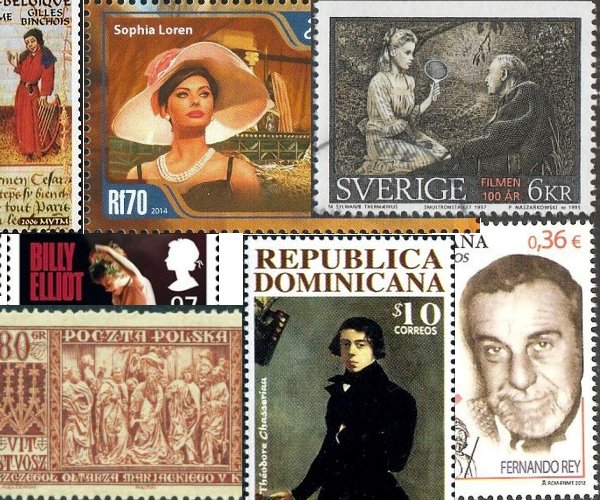
By Doug Briscoe
Sinclair Lewis? Yes. Upton Sinclair? No. Nothing for Maxwell Perkins, either. Sinclair and Perkins were both born on this date, the novelist in 1878 (d. November 25, 1968) and the editor in 1884 (d. 17 June 1947).
The film arena dominates our piece today, as we salute Sophia Loren, Fernando Rey, whose centenary it is today, Victor Sjöström, Kenneth More, and the Cannes Film Festival.
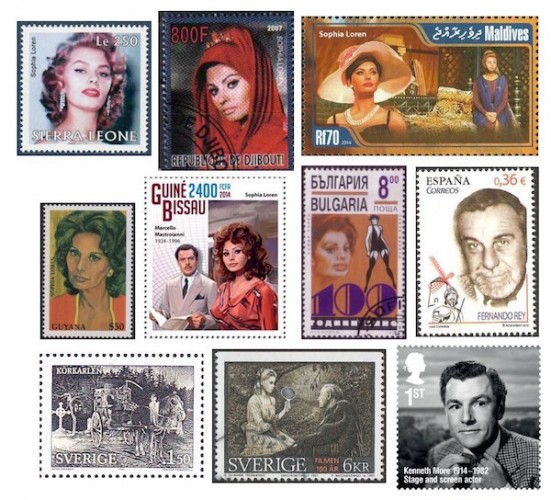
Sofia Costanza Brigida Villani Scicolone—Sophia Loren, to you and me—turns 83 today! The glamorous Italian actress appears on a number of worldwide stamps (sharing the spotlight on the ones from Guinea-Bissau and Bulgaria with Marcello Mastroianni and Liza Minnelli respectively). It may not be surprising that Sofia, aged 15, went uncredited as an extra in her first film, except that the film happened to be Quo Vadis (1951), and Elizabeth Taylor, who was already a star, was also uncredited in that movie! (Taylor had been considered for the leading role, but ended up appearing in just one scene as a Christian in the arena.) I have another personal anecdote thanks to my 60s jetsetter sister Ellen, who was a dear friend of Beebe Kline, Sophia Loren’s Hollywood agent. My sister went to visit Beebe one evening, and as she arrived Ms. Loren was doing the elderly Beebe the favor of taking out her garbage.
Another European star, and a great one, Fernando Rey, was born on this day one hundred years ago. The Spanish actor, originally Fernando Casado Arambillet (20 September 1917 – 9 March 1994), had his first speaking role in 1944. He famously collaborated with Luis Buñuel on a number of projects including The Discreet Charm of the Bourgeoisie (1972) and That Obscure Object of Desire (1977). His best known English-language film was probably The French Connection (1971).
It’s a bit ironic that Swedish film director Victor Sjöström (20 September 1879 – 3 January 1960), who accomplished so much, is probably best known for a single acting role he took late in life. This was the appealing role of the kindly Professor Isak Borg in Ingmar Bergman‘s Wild Strawberries (1957). But Sjöström, having acted as a teenager with a touring theater company, had directed his own first film as early as 1912. His other early work in the silents included The Phantom Carriage (1921), seen on one of the Swedish stamps, and, in Hollywood, where he was sometimes known as Victor Seastrom, the masterpieces He Who Gets Slapped (1924) with Lon Chaney and The Wind (1928) with Lillian Gish (birthday next month). Other actors he directed in those days were Greta Garbo, John Gilbert, and Norma Shearer. He went back to Sweden and directed just another couple of films. After 1937 he returned to the theater for many years, with occasional appearances in film as an actor. At age 78 he accepted the part of Professor Isak Borg in Bergman’s masterpiece. A still appears on the other Swedish stamp.
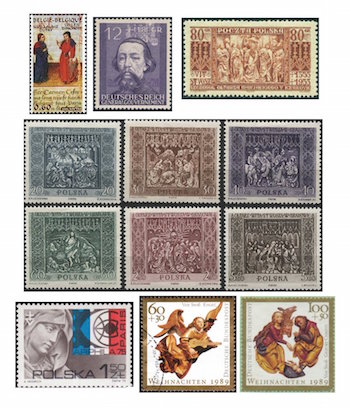
Another actor not so well known in the United States but much loved at home was Kenneth More (20 September 1914 – 12 July 1982). The English actor’s stage career began with comedy routines. Service as a lieutenant with the Royal Navy during World War II interrupted this career, but he went right back to it in 1946. His first hits were Genevieve (1953) and Doctor in the House (1954). Later projects included The Admirable Crichton (1957), A Night to Remember (1958), and the television series The Forsyte Saga (1967) and Father Brown (1974).
We have no classical music birthdays on stamps for today, but on this date in 1460, Gilles de Binche, better known today as Gilles Binchois, died. He was born some time around 1400. On the only stamp honoring him he is paired with another great early music composer, Guillaume Dufay.
We include the German woodcarver Veit Stoss in today’s lineup because he may have died on the 20th of September in the year 1533. Born sometime before 1450—maybe 1447—Stoss (or, to give the Polish version of his name, Wit Stwosz) was active in Nuremberg and Kraków, where he executed the stunning altarpiece of St Mary’s Church (completed 1489). The central section of this work is shown on an old Polish stamp of 1933. In 1960 Poland issued a full set of stamps reproducing details of this masterpiece. A 1975 issue shows the face of Stoss’s St. Anne (bottom panel, right wing, also shown on the 5.60 złoty value of the 1960 set). In 1941 the Nazis dismantled the altar and hid it in Bavaria, where it was uncovered in 1945 and fully restored in Kraków ten years later. It was also the Third Reich that issued the only portrait stamp we have of the artist under the “Generalgouvernement” of occupied Poland in 1942. For a 1989 Christmas issue, Germany released a pair of stamps showing carvings from St. Lawrence’s Church in Nuremberg. Veit Stoss appears as a character in Judith Weir’s opera The Black Spider (1985).
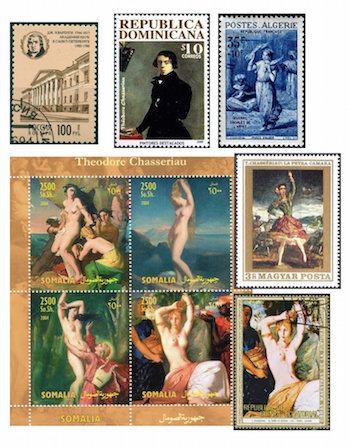
Another artist whose name is variously represented is Italian architect Giacomo Quarenghi (20 or 21 September 1744 – 2 March [O.S. 18 February] 1817), active in Russia, where he was styled Džákomo Kvaréngi (Джа́комо Кваре́нги). Scion of a noble family, he was born near Bergamo and studied there with a student of Tiepolo. In Rome he took lessons with Anton Raphael Mengs, later moving to the study of architecture, in which choice he may have been confirmed by a chance encounter with Andrea Palladio’s Four Books of Architecture. In Venice in 1771-72, Quarenghi happened to meet a traveling British lord through whom the architect received a few small English commissions. His reputation had grown by 1779 to the point that he was “head-hunted” by an emissary of Catherine II. Perhaps it was no coincidence that his first work for her was the English Palace in Peterhof (lost during WWII). Quarenghi went on to work on a large number of projects in Russia for the empress and her court. One of these, the Academy of Sciences (1783-89), is shown on the Russian stamp of 1994.
Next we come to a gifted French painter who studied with Ingres but also drank in the influence of Delacroix and sought to synthesize their disparate styles (Neoclassical vs Romantic). This was Théodore Chassériau (September 20, 1819 – October 8, 1856), who was born on the island of Santo Domingo (now the Dominican Republic) to a French father and a mulatto mother, daughter of a prominent landowner. The family relocated to Paris when Théodore was a baby, and as he grew he exhibited great talent in drawing, such that he was accepted as a student by Ingres at the age of only 11. Soon he was Ingres’ favorite pupil, but by the time the men met again in Rome in 1840, Chassériau had discovered Delacroix, much to Ingres’ distaste, and the older man broke off the relationship. But Théophile Gautier was an admirer. I was surprised and pleased to find as many as four stamps and a sheetlet of Chassériau’s work. We begin with a stamp from, appropriately enough, the Dominican Republic, with Portrait of the Artist in a Redingote (1835), a self-portrait Chassériau made at the age of 16. (A parenthesis: the history of the word “redingote” is amusing. An English word for a long coat derived, it was thought, from the French, it turned out to be based on the French pronunciation of the English “riding coat”!) The earliest stamp showing the work of Chassériau is an Algerian issue (Chassériau visited Algeria for the first time in 1846 and evinced Orientalist tendencies in some of his subsequent works) showing a detail from Moorish Dancers (1849). The Hungarian stamp offers what is more clearly a work owing its style to Delacroix and the Romantics: La Petra camara (1854). The enticing Somalia sheet gives us, at upper left, Andromeda Chained to the Rock by the Nereids (1840); at upper right Venus Anadyomene (1838-39); at lower left Apollo and Daphne (1845); and finally Esther (1841), also seen on a stamp from Equatorial Guinea.
German painter and graphic artist Harald Hakenbeck (20 September 1926) turns 91 today. His breakthrough came in 1961 with the work shown on the first of our two DDR stamps, Peter in the Zoo (Peter im Tierpark) (1961). The other shows Hakenbeck’s Fisherman’s House, Vitte (1963).
Remaining in Germany, we salute architect Hans Scharoun (20 September 1893 – 25 November 1972), whose most familiar work is Berlin’s Philharmonie Hall (1956–63), seen on two German stamps. Born in Bremen, Scharoun studied architecture in Berlin until 1914, served in the First World War, and joined the architects’ group the Glass Chain. He also organised art exhibitions, including one for the expressionist group Die Brücke. He remained in Germany during the Nazi period, biding his time and concentrating on reconstruction work. After the war the Allies named him to the Berlin building council. Another of his distinctive works is the Schminke House in Saxony. His only building outside Germany is the German Embassy in Brasília (1963-69).
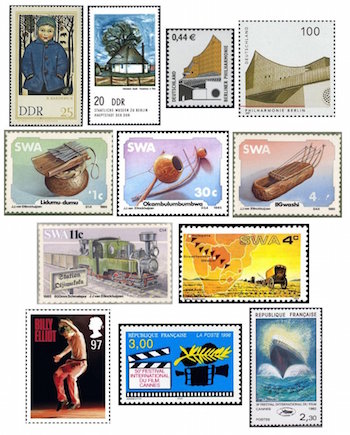
It’s time for another stamp designer, this time one from South Africa. The late Jacobus Johannes “Koos” van Ellinckhuijzen (20 September 1942 – 6 September 2016) was born to Dutch parents and came rather late in life to painting, concentrating on surrealist works. As a stamp designer he was responsible for many Namibian and South-West African issues. I show a small sample, including a nice set of traditional musical instruments.
The best known work of English playwright Lee Hall (born 20 September 1966) is his screenplay for Billy Elliot (2000), which he later developed into the wildly successful Billy Elliot: The Musical (2005). He also wrote the screen adaptation for the 2005 Pride and Prejudice (with Keira Knightley) and co-authored the screenplay for Steven Spielberg’s War Horse (2011). In addition, Lee has translated plays by Brecht, Goldoni, and Herman Heijermans.
Finally today, we acknowledge the First Cannes International Film Festival, which first took place on 20 September 1946, with twenty-one countries submitting their films. Among these were Roberto Rossellini’s Rome, Open City, David Lean’s Brief Encounter, and Billy Wilder’s Lost Weekend. The festival had been planned for 1939, but World War II intervened. The Palme d’Or was introduced in 1955. Two French stamps recognize the festival itself. A number of others celebrate specific films, but we’ll reserve those for the birthdays of their directors and/or stars.
And a happy 69th birthday to Game of Thrones creator George R. R. Martin (born September 20, 1948). I strongly suspect that HBO has severely restricted the image rights to the series, else we’d be seeing a slew of lucrative GoT stamps from all over. I also suspect their day will come.
A graduate of the University of Massachusetts with a B.A. in English, Doug Briscoe worked in Boston classical music radio, at WCRB, WGBH, and WBUR, for about 25 years, beginning in 1977. He has the curious distinction of having succeeded Robert J. Lurtsema twice, first as host of WGBH’s weekday morning classical music program in 1993, then as host of the weekend program when Robert J.’s health failed in 2000. Doug also wrote liner notes for several of the late Gunther Schuller’s GM Recordings releases as well as program notes for the Boston Classical Orchestra. For the past few years he’s been posting a Facebook “blog” of classical music on stamps of the world, which has now been expanded to encompass all the arts for The Arts Fuse.
